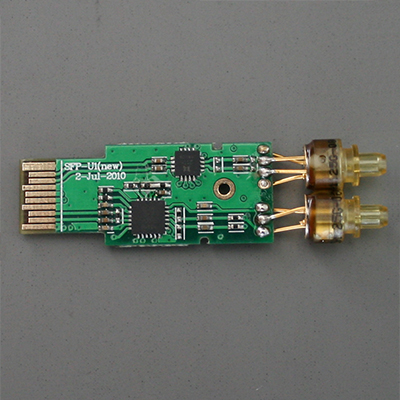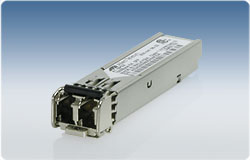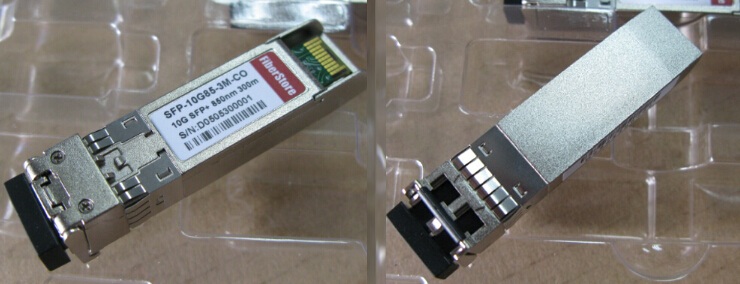|
Fiber optic transceivers are key components of fiber optic transmission network. They are designed in small form-factor with some integrated optical sub-assemblies which can be suitable for high-density network. The major cost components of a transceiver module are the transmitter optical sub-assembly (TOSA), which converts an electrical and the receiver optical sub-assembly (ROSA). However, inside a BiDi (Bi-Directional) transceiver, there is a component with called "BOSA" (Bidirectional Optical Sub-Assemblies) which acts the role of TOSA and ROSA but with different principle.  TOSASemiconductor lasers used in fiber optics industry are small, sensitive devices. They are typically a few hundred mic ... Read more » |
|
AT-SPSX Overview
AT-SPLX10 Overview The AT-SP10LR is a hot pluggable 10Gbps small form factor transceiver Module. It is compliant with the SFF-8431 SFP+ Electrical Multi-source Agreement (MSA) with five digital monitoring functions: Temperature, Vcc, Tx opt ... Read more »
Views:
437
|
|
Date:
12.03.2015
|
AFBR-703SDZ & AFCT-701SDZ OverviewThe Avago AFBR-703SDZ transceiver is part of its SFP+ SR product family. This transceiver uses Avago’s 850 nm VCSEL and PIN detector technology to provide an IEEE 10 Gbs Ethernet design compliant with the 10 GBASE-SR standard. The AFBR-703SDZ transceiver is designed to enable 10 Gbs Ethernet equipment designs with very high port density based on the new electrical and mechanical specification enhancements to the well known SFP+ specifications developed by the SFF Committee. The Avago AFCT-701SDZ transceiver is part of its SFP+ LR product family. This transceiver uses Avago’s 1310 nm DFB and PIN detector technology to provide an IEEE 10 Gbs Ethernet design compliant with the 10 GBASE-LR standard. The AF ... Read more »
Views:
395
|
|
Date:
11.12.2015
|
|
SFP+ transceiver is widely deployed in applications and becomes much more pervasive due to its smaller form factor, less power consumption and its increased port density compared with XFP transceiver. Each SFP+ transceiver houses an optical receiver and transmitter. One end of the transceiver is an optical connection complying with the 10GbE and 8GFC standards, while the other end is an SERDES framer interface (SFI) serial interconnect handling differential signals up to 10 Gbit/s. In order to keep a SFP+ transceiver achieving high performance, the engineers need to acquaint with the key challenges related to testing SFP+ transceiver. This article will first walk through the SFP+ testing challenges and then focus on one kind of testing measurement. SFP+ Testing ChallengesWhile SFP+ helps to reduce overall system cost, it puts new burdens on the PHY’s design and performance. Keep in mind that there may be numerous challenges related to t ... Read more »
Views:
310
|
|
Date:
11.05.2015
|
|
As technology continues to improve, the size of transceiver modules has become smaller and smaller. In addition to the size, the rate of optical transceiver also becomes faster and faster, such as 1.25 G, 2.5 G, 4 G, 10G, 40G and 100G, etc. However, when came up to 10G, people found that the encapsulation is too small to keep many components. In order to solve this problem, XFP modules were launched as a new transceiver standard. Here is what you need to know about XFP optical transceivers technology. Introduction of XFP Transceiver In fact, XFP is not the first 10G transceiver in the market. The 10G transceiver market has gone through 300Pin and XENPAK/XPAK/X2 before XFP came out. As these types of products are intergrated with SerDes chips, we usually call them transponders instead of transceivers. XFP optical transceivers support up ... Read more »
Views:
507
|
|
Date:
10.29.2015
|
|
The small form-factor pluggable (SFP) transceiver was jointly developed by many of the world's leading network vendors, and it is now widely used in optical network systems. The SFP module was designed under the Multi-Source Agreement (MSA) which meant that the specification for the interface and electrical operation were standardised between vendors. Here are some common questions we might have when using SFP transceivers. And from the answers, we might have a deeper understanding of using these SFP optics. Can I pair different types of SFP transceivers? No. You should use the same type of SFP transceiver at both ends. What type of optical fiber cable should I use with these SFP modules? You should use an optical fiber cable with LC connector, wh ... Read more »
Views:
344
|
|
Date:
10.22.2015
|
|
As one of the most important components of PON (Passive Optical Network) systems, the market of PLC (Planar Lightwave Circuit) splitters has grown rapidly. If you are the first time to buy PLC splitters, you might be curious about the package type of it. Actually, it is not as complex as you think. Different Package Type PLC Splitters At present, there are six major package type of PLC splitters according to different applications, suce as, bare fiber splitter, module splitter, rack-mount splitter, fan-out & blockless splitter, Tray splitter and LGX splitter. Of course, these are the basic types and there are upgrade version on their foundation offered by different vendors. For example, the following shows us the PLC splitters of Fiberstore with different package types.
Views:
387
|
|
Date:
10.14.2015
|
|
Since the invention of optical fibers in the early 1970s, the use of and demand for optical fiber today are quite numerous. With the explosion of information traffic due to the Internet, electronic commerce, computer networks, multimedia, voice, data, and video, the need for large amount of signal transmission is paramount. Fiber optics has proven to be the best solution. Single-mode fiber is one of optical fibers which is designed for the transmission of a single ray or mode of light as a carrier and is used for long-distance signal transmission. A typical single-mode fiber has four parts: the core, cladding, buffer and jacket. In the center, it’s ... Read more » |
|
Several factors make 10GbE implementations a compelling option, including interoperability, cost efficiency, low power consumption, communication quality, and hardware availability. Each of these factors merits careful consideration. Interoperability Leveraging Existing Technology During infrastructure upgrades, 10GbE and the TCP/IP protocol are designed to interoperate seamlessly with GbE links, enabling a relatively easy and nondisruptive transition to 10GbE. Two different types of 10GbE connectors are expected to facilitate these links, including 10GBase-T copper and the 10GbE small form-factor pluggable+ (SFP+) interconnect. SFP+ supports different physical port types such as 10GBASE Twinax copper and various types of fiber connections. By helping ensure that the 10GbE components can cooperatively communicate with GbE devices, switch vendors can deliver interoperability between GbE and 10GbE. Data transitioning from 10GbE to GbE links pot ... Read more »
Views:
282
|
|
Date:
06.26.2015
|
|
Overview
As the technology and market of optical transceivers continue to mature, 3rd-party SFP+ optical transceivers, especially the 10GBASE SR SFP and 10GBASE-LR SFP modules which are now widely used in optical transmission solutions, In order to ensure compliance, 3rd-party SFP+ optical transceivers need to be tested and verified before inserting to the device. This paper will talk something about t ... Read more »
Views:
261
|
|
Date:
06.16.2015
|

 The
The 